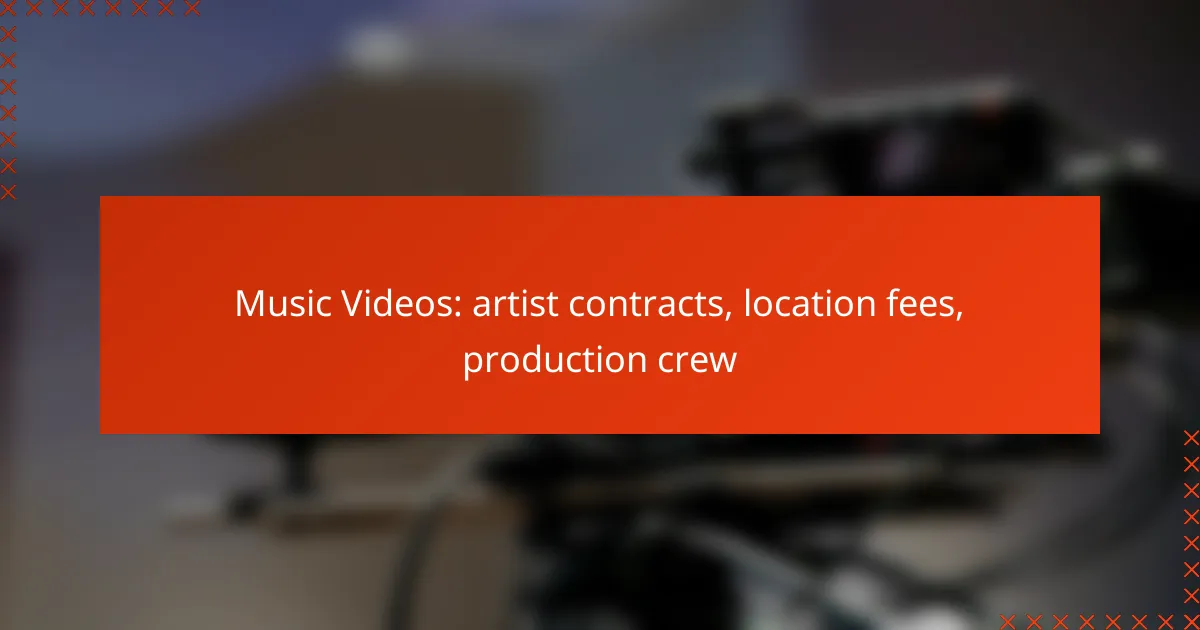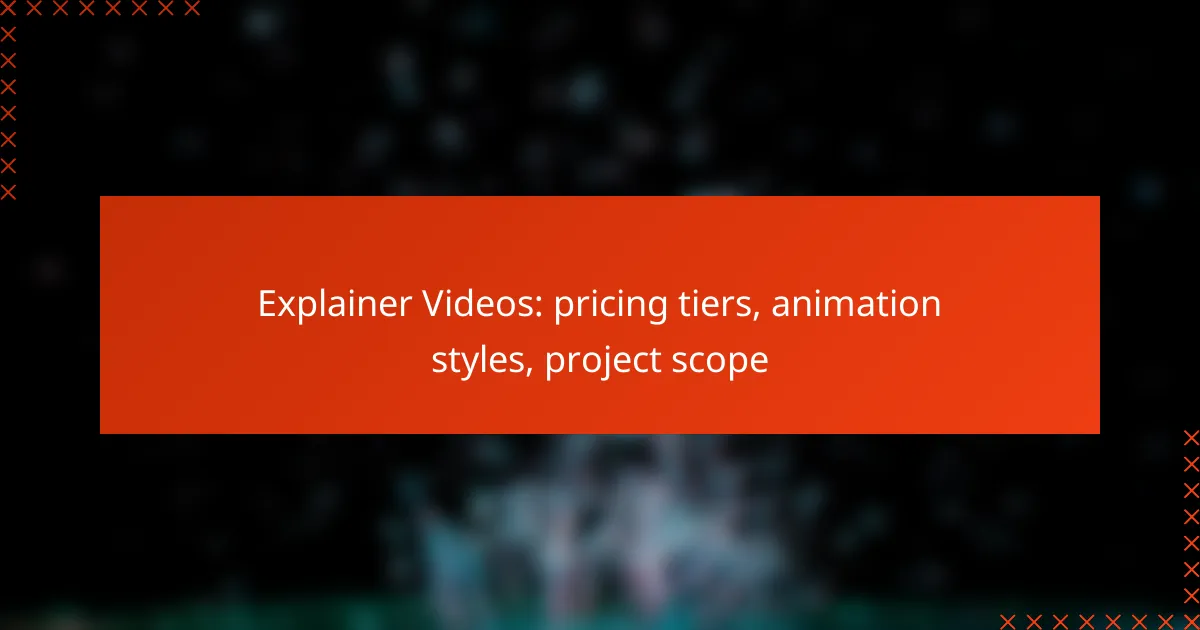Branded content partnerships can entail varying costs influenced by project scope, platform choices, and creative development needs, with investments ranging from a few thousand to several hundred thousand dollars. Crafting effective branded content requires a strategic approach that combines storytelling and audience engagement to align with brand messaging. Additionally, selecting the right distribution channels is crucial for maximizing visibility and ensuring the content resonates with the target audience.
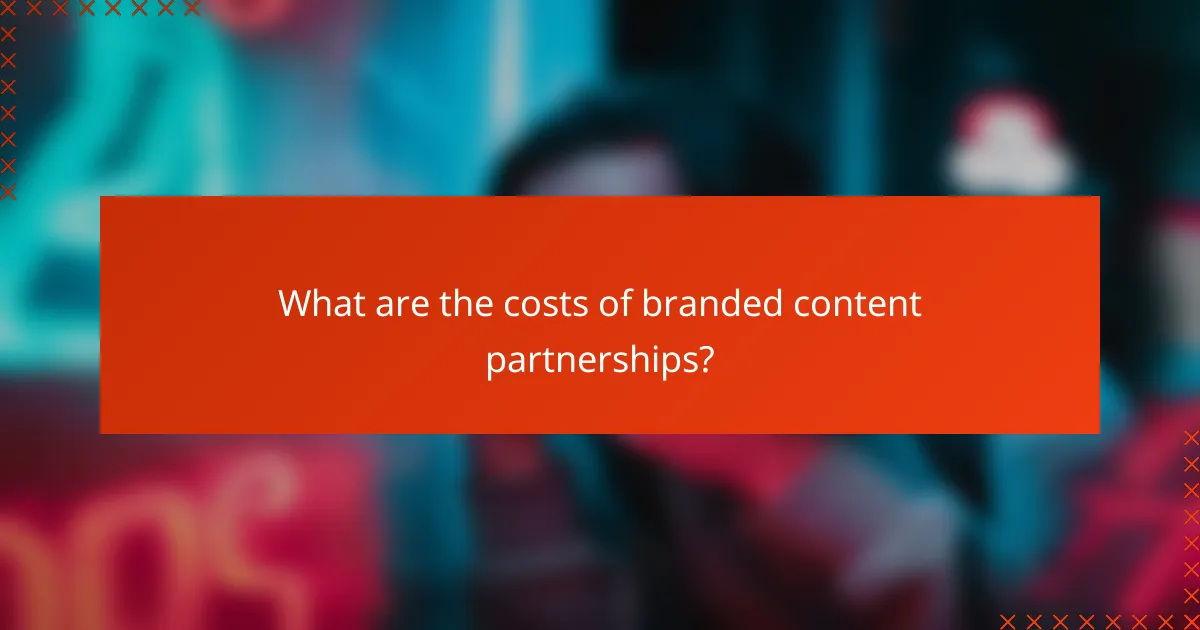
What are the costs of branded content partnerships?
The costs of branded content partnerships can vary significantly based on multiple factors, including the scope of the project, the platforms used, and the level of creative development required. Typically, businesses should expect to invest anywhere from a few thousand to several hundred thousand dollars, depending on their goals and the complexity of the campaign.
Average partnership costs in the US
In the United States, branded content partnerships generally range from $5,000 to $100,000 or more. Smaller campaigns might start at the lower end, while larger, more comprehensive projects involving high-profile influencers or extensive media distribution can reach the upper limits. For example, a simple social media post might cost around $5,000, while a full-scale video production could easily exceed $50,000.
Factors influencing partnership pricing
Several factors can affect the pricing of branded content partnerships. Key considerations include the type of content being created, the platforms for distribution, and the audience reach. Additionally, the reputation and experience of the content creators can significantly influence costs; established brands or influencers typically charge more due to their proven track record.
Other factors include the duration of the campaign and the level of engagement required. For instance, a short-term campaign may be less expensive than a long-term partnership that necessitates ongoing content creation and audience interaction.
Case study: Successful branded content campaigns
A notable example of a successful branded content campaign is the collaboration between Red Bull and GoPro. This partnership effectively showcased extreme sports through high-quality video content, engaging audiences and enhancing brand visibility. The campaign reportedly generated millions in revenue, highlighting the potential return on investment for well-executed branded content.
Another example is the partnership between Nike and various athletes, where the brand creates compelling narratives around their stories. These campaigns not only promote Nike products but also resonate deeply with consumers, driving brand loyalty and sales. Such case studies illustrate how strategic partnerships can yield significant benefits when executed thoughtfully.

How to develop creative branded content?
Developing creative branded content involves a strategic blend of storytelling, audience engagement, and brand messaging. It requires understanding your target audience and crafting content that resonates while promoting your brand’s values.
Key elements of effective content creation
Effective content creation hinges on several key elements, including clarity, relevance, and emotional appeal. Content should clearly convey the brand message while being relevant to the audience’s interests and needs.
Additionally, incorporating visual elements like images and videos can enhance engagement. Aim for a mix of informative and entertaining content to keep your audience interested and encourage sharing.
Collaboration with creative agencies
Partnering with creative agencies can elevate your branded content by leveraging their expertise in storytelling and design. Agencies often have access to advanced tools and a team of specialists who can bring fresh perspectives to your projects.
When collaborating, clearly communicate your brand goals and target audience. Establishing a mutual understanding will help align the creative direction with your brand’s vision, leading to more impactful content.
Tools for content development
Utilizing the right tools can streamline the content development process. Platforms like Canva or Adobe Creative Suite offer design capabilities, while content management systems (CMS) like WordPress help organize and publish your content efficiently.
Additionally, analytics tools such as Google Analytics can provide insights into audience behavior, helping refine your content strategy over time. Consider integrating project management tools like Trello or Asana to keep your team organized and on track.

What are the distribution strategies for branded content?
Distribution strategies for branded content involve selecting the right channels and methods to effectively reach and engage the target audience. These strategies can significantly impact the visibility and success of the content, making it essential to choose wisely based on the brand’s goals and audience preferences.
Popular distribution channels
Common distribution channels for branded content include social media platforms, websites, email newsletters, and video-sharing sites. Each channel offers unique advantages; for instance, social media allows for rapid sharing and engagement, while email newsletters can provide direct access to a loyal audience.
Brands often leverage a mix of these channels to maximize reach. For example, a campaign might use Instagram for visual storytelling, YouTube for longer-form content, and a blog for in-depth articles, creating a cohesive strategy across platforms.
Measuring distribution effectiveness
To assess the effectiveness of branded content distribution, brands should track key performance indicators (KPIs) such as engagement rates, reach, impressions, and conversion rates. These metrics provide insights into how well the content resonates with the audience and its impact on brand objectives.
Utilizing tools like Google Analytics and social media insights can help brands analyze performance. Regularly reviewing these metrics allows for adjustments in strategy, ensuring that content distribution remains aligned with audience interests and behaviors.
Case study: Distribution success stories
One notable success story is the Red Bull Stratos project, where branded content was distributed through live streaming and social media, attracting millions of viewers worldwide. This innovative approach not only showcased the brand’s adventurous spirit but also engaged audiences in real-time, creating a memorable experience.
Another example is Nike’s “Dream Crazy” campaign, which utilized a multi-channel approach, including TV ads, social media, and influencer partnerships. The campaign’s distribution strategy effectively reached diverse demographics, resulting in significant increases in brand engagement and sales.
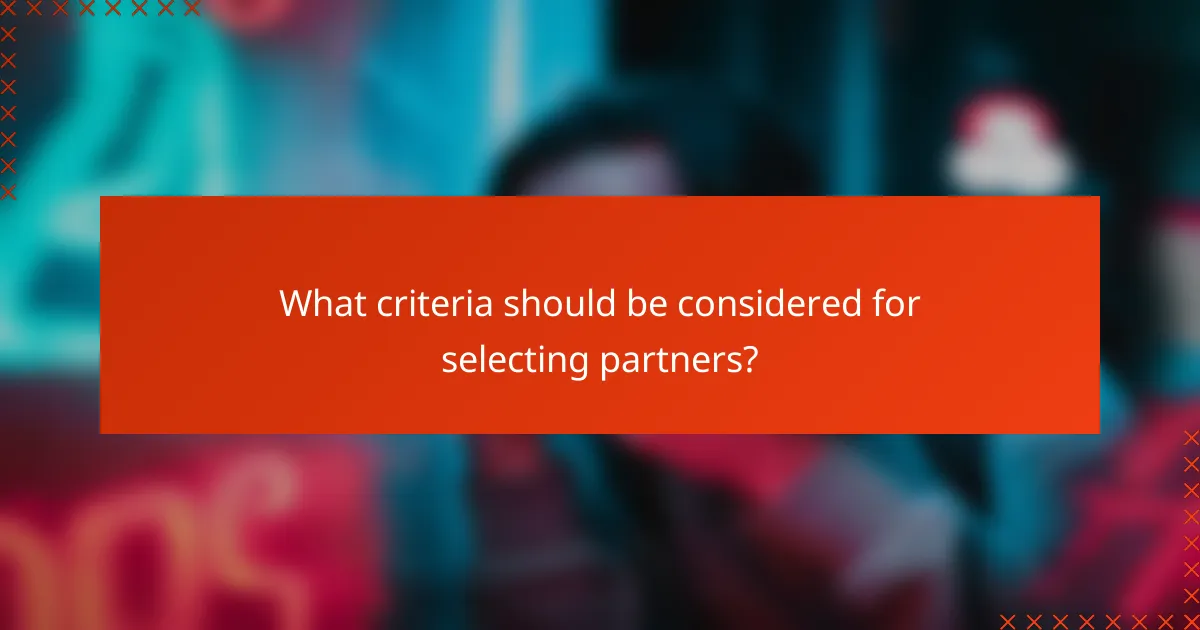
What criteria should be considered for selecting partners?
Selecting partners for branded content involves evaluating several key criteria to ensure alignment and effectiveness. Consider factors such as brand alignment, audience demographics, and the potential for creative collaboration to maximize the impact of your content.
Brand alignment factors
Brand alignment is crucial for successful partnerships. Look for partners whose values, mission, and overall brand identity resonate with your own. This ensures that the content feels authentic and appeals to both audiences.
Evaluate the partner’s previous work and reputation in the market. A well-aligned partner can enhance your brand’s credibility, while a mismatch may confuse or alienate your target audience. Aim for brands that complement your offerings rather than compete directly.
Audience demographics
Understanding audience demographics is essential when selecting partners. Analyze the age, gender, location, and interests of both your audience and that of potential partners. This helps ensure that the content reaches the right people effectively.
Consider using tools like surveys or analytics to gather data on audience preferences. A partner with a similar or overlapping demographic can amplify your message and increase engagement, making it more likely that the branded content will resonate with viewers.
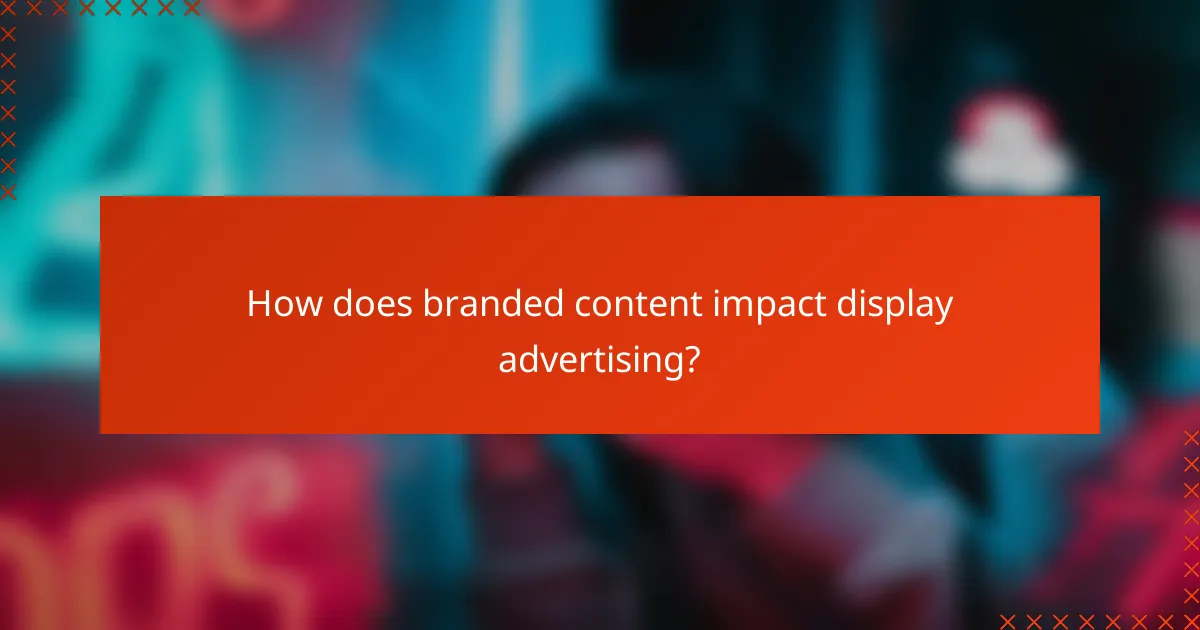
How does branded content impact display advertising?
Branded content significantly enhances display advertising by fostering deeper audience engagement and building brand loyalty. This approach integrates storytelling with promotional messages, making ads more relatable and memorable for consumers.
Engagement metrics comparison
Branded content typically yields higher engagement metrics compared to traditional display ads. For instance, users may spend several minutes interacting with a well-crafted branded video, while standard display ads often capture attention for mere seconds. Metrics such as click-through rates (CTR) and time spent on content can be two to three times higher for branded content.
Brands should monitor engagement through analytics tools to assess performance. Key metrics to track include social shares, comments, and overall reach. A strong engagement rate can indicate effective messaging and audience resonance.
ROI of branded content in advertising
The return on investment (ROI) for branded content can be substantial, often exceeding that of traditional advertising methods. While initial costs may be higher due to creative development, the long-term benefits include increased brand awareness and customer loyalty, which can lead to higher sales conversions.
To evaluate ROI, brands should consider both direct and indirect returns. Direct returns can include increased sales figures, while indirect returns may encompass improved brand perception and customer retention rates. A well-executed branded content strategy can yield ROI percentages in the double digits over time.

What are the emerging trends in branded content?
Emerging trends in branded content focus on innovative strategies that enhance audience engagement and brand visibility. Key developments include influencer collaborations and interactive content formats that resonate with consumers in a more personal and immersive way.
Influencer collaborations
Influencer collaborations involve partnering with individuals who have a significant following on social media platforms to promote branded content. This trend allows brands to tap into the influencer’s established audience, often resulting in higher engagement rates and authenticity.
When considering influencer partnerships, brands should evaluate the influencer’s audience demographics, engagement metrics, and alignment with brand values. Compensation can vary widely, typically ranging from a few hundred to several thousand USD per post, depending on the influencer’s reach and impact.
Interactive content formats
Interactive content formats engage users by allowing them to participate actively rather than passively consuming information. Examples include quizzes, polls, and augmented reality experiences that encourage user interaction and can significantly boost brand recall.
Brands should focus on creating interactive experiences that are relevant to their target audience. These formats can enhance user engagement and provide valuable data on consumer preferences. However, it’s essential to ensure that the interactive elements are user-friendly and accessible across various devices to maximize participation.


